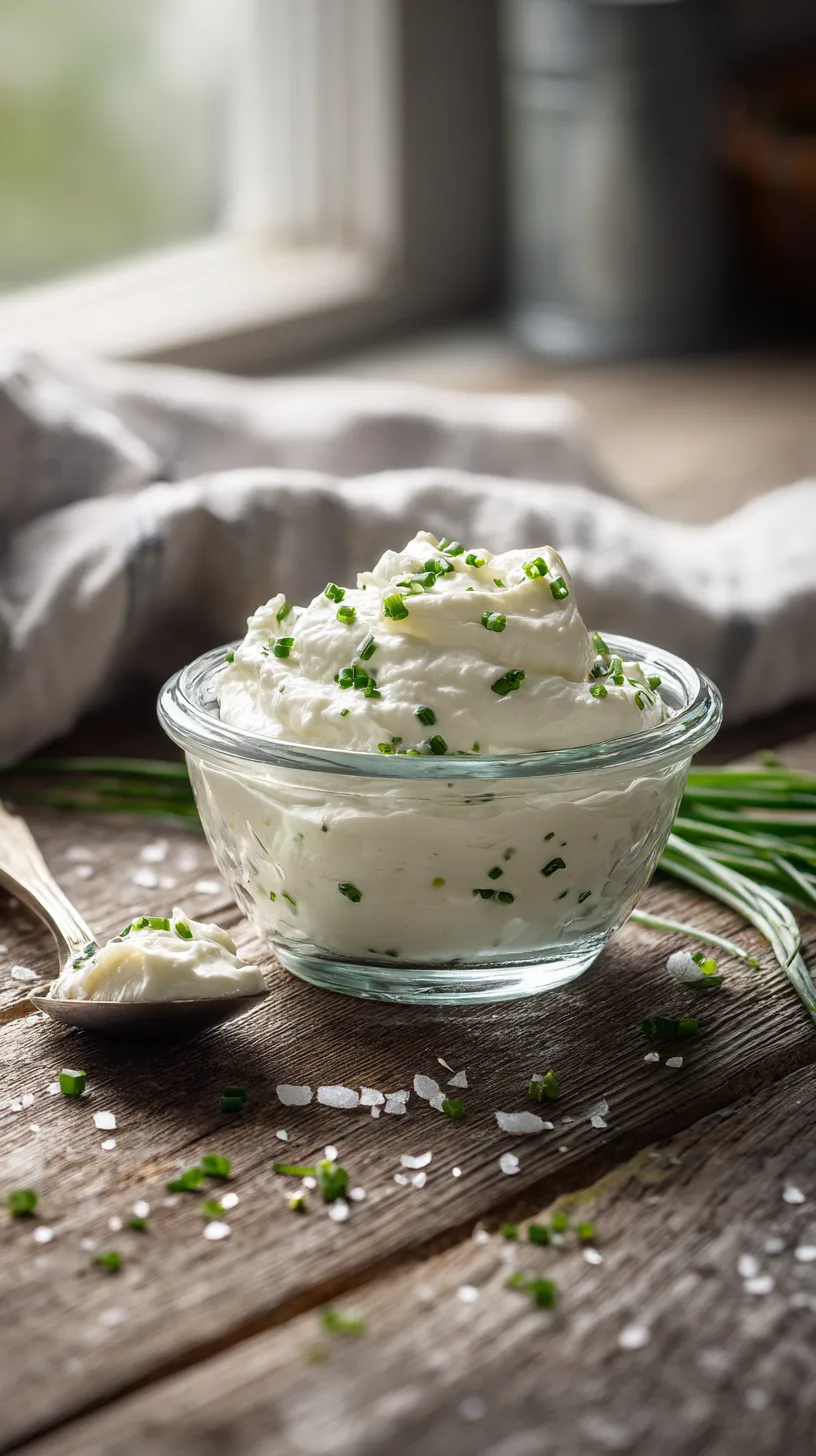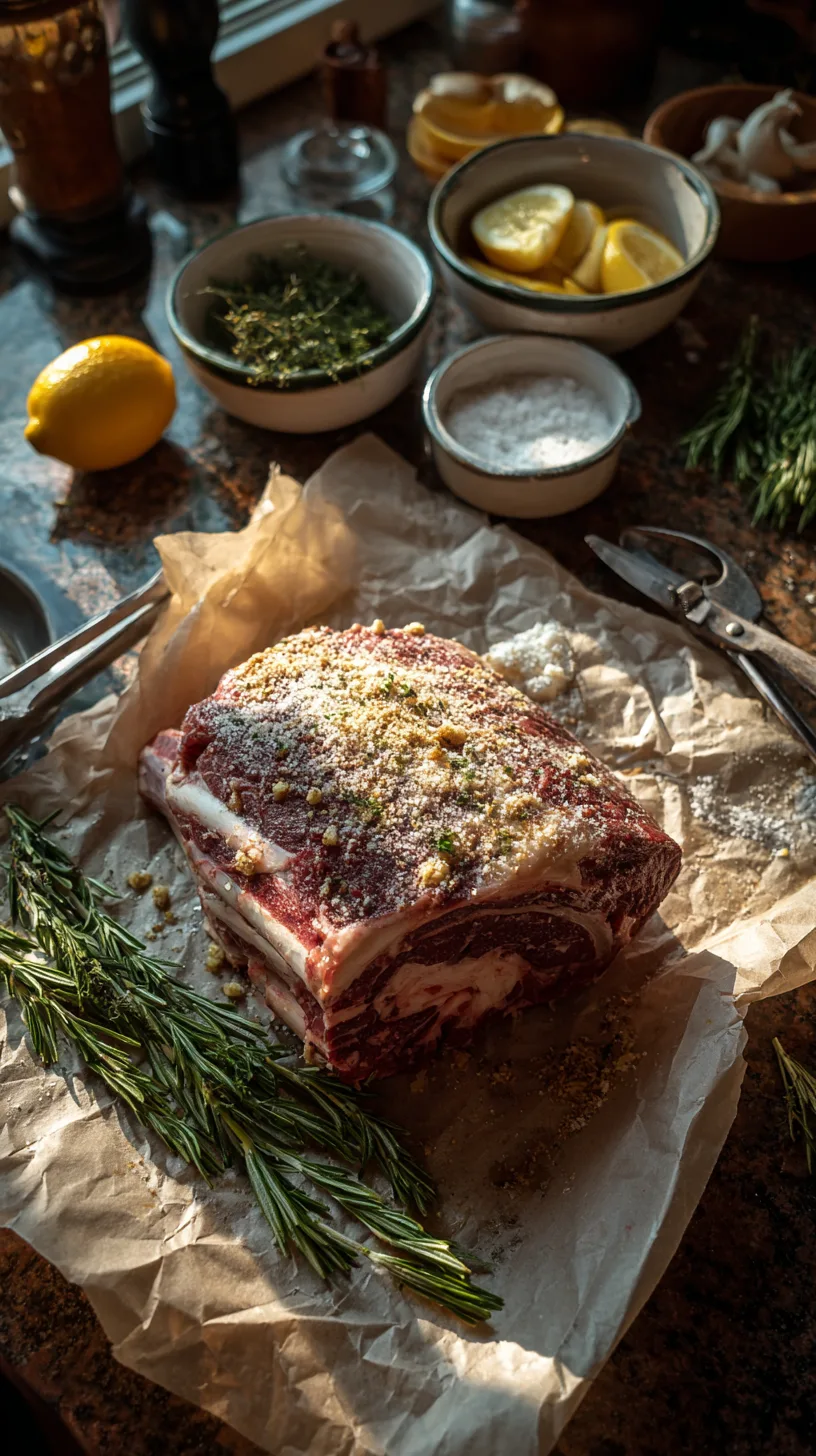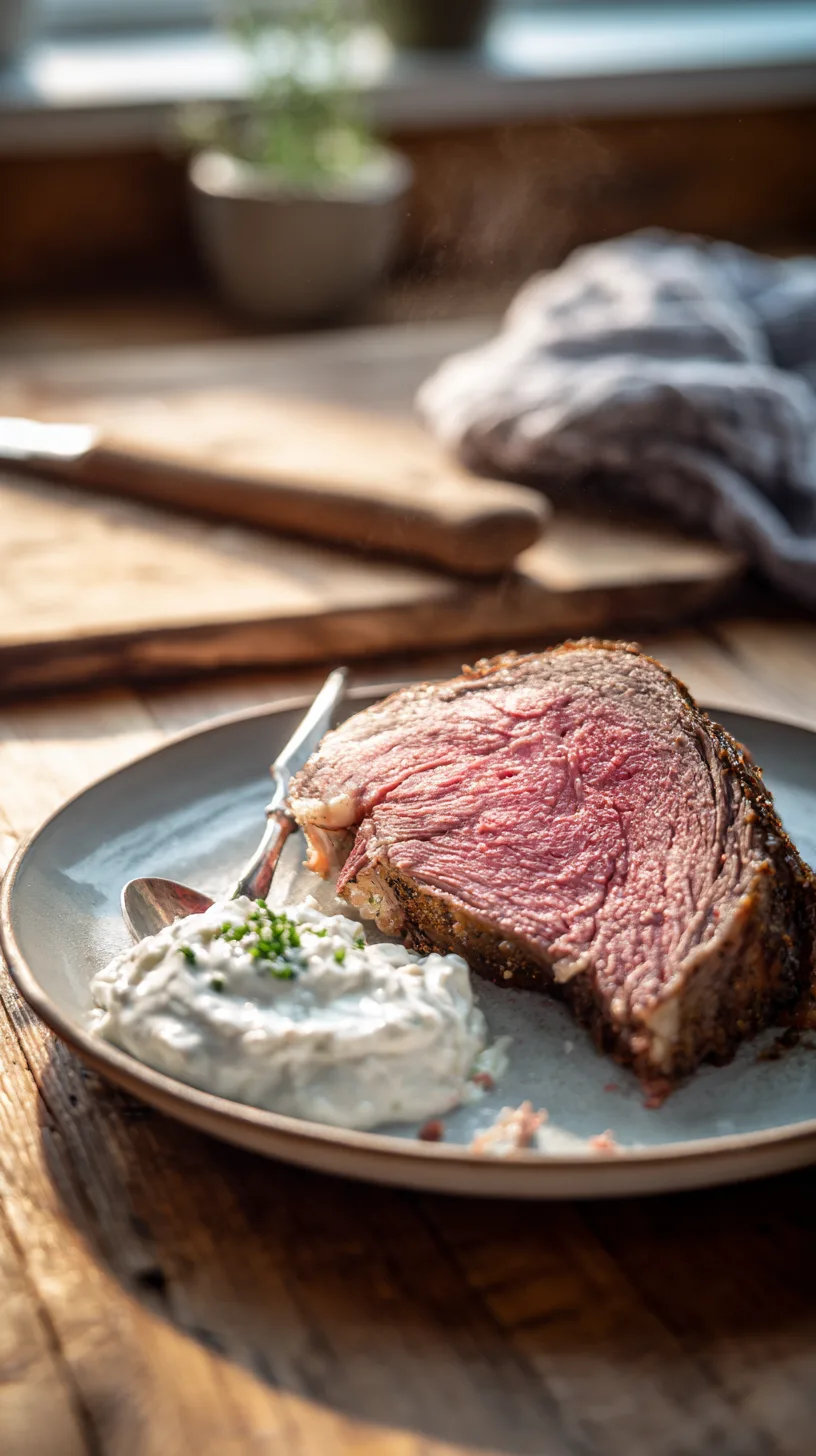Prime Rib with Horseradish Cream Sauce That Stopped the Table
Every family’s got that one dish that brings the noise down. Forks pause, eyes lift, and someone lets out a quiet “damn.”
That’s this roast.
For years I watched it happen from behind the line, thick slices of prime rib sliding onto hot plates, the smell of beef fat and thyme filling the air.
Then the sauce – cool, sharp, alive – cut through it all. You’d see it in people’s faces. Relief. Surprise. Maybe a little gratitude.
Holiday meals can do that to you.
They carry pressure.
You want the meal to mean something. But when you nail a roast like this, with its blush-pink center and the whisper of horseradish that wakes everything up, the whole room exhales.
After twenty years of cooking up and down the coast – from a beachside inn in Santa Cruz to a banquet kitchen in Los Gatos – I’ve learned that prime rib isn’t hard.
It just doesn’t like to be rushed. The secret isn’t in the ingredients. It’s in the patience.
If you’re mapping out the rest of your holiday spread, browse our full recipe collection and pull a few supporting sides to round out the prime rib.
The Roast That Teaches You to Slow Down
I used to think the big secret was temperature. It’s not. It’s timing.
You can’t bully a rib roast.
Try to blast it hot, and you’ll end up with that bullseye effect – gray outside, raw center.
The trick is low and slow, 225°F, then the roar of heat at the end. Reverse sear.
I first picked it up from the OG Alton Brown. Watching him in that Good Eats kitchen and listening to his philosophy changed how I thought about cooking. Especially when it comes to Prime Rib.
Alton was right.
When the internal hits around 120 – 125°F, you rest it.
Not ten minutes like the internet says.
A full hour, tented in foil.
During that time, something magical happens inside.
The juices redistribute, the fibers relax, and the meat stops fighting you.
That’s when you bring the fire back – 500°F, ten minutes – to finish the crust. You’ll hear it crackle.
It’s a sound that feels like applause.
For a bright counterpoint to the beef-and-herb profile, bookmark this fresh, beef-friendly authentic chimichurri as an alternate sauce on the table.
A Sauce That Wakes the Table Up

Most horseradish sauces are lazy.
Just sour cream and a spoonful of something sharp from a jar.
Fine.
But when you fold in whipped cream, it becomes something else entirely – airy, cool, a little wild.
I picked that trick up in a wine country kitchen outside Healdsburg.
We were doing prime rib for 200, and I needed a sauce that wouldn’t die on the buffet. Heavy cream saved the night.
Whip it soft, fold in crème fraîche, lemon, and horseradish. It holds for hours, and it feels like velvet on hot beef.
The chives matter.
Don’t skip them.
They’re not garnish – they’re punctuation.
They give the sauce this quiet hum, that green taste that keeps your palate from drowning in fat.
If you’re into swaps, I’ve done this same sauce with wasabi root for a Japanese tasting dinner, and with pickled green garlic for spring events. Each has its moment. But horseradish is the anchor.
If you like the slow-cook rhythm, compare textures by practicing low-and-slow on our red wine beef stew—it teaches patience and doneness cues you’ll use on prime rib.
On the Hunt for the Right Rib

I buy mine from a rancher down near Watsonville who dry-ages in an old walk-in that smells faintly of oak and salt. That funk makes a difference. The meat’s got this nutty edge before it even hits the pan.
If you’re shopping retail, look for “standing rib roast,” bone-in, well-marbled, creamy white fat. Don’t chase USDA Prime unless you’re feeling flush; Choice with good marbling will carry you fine. Always ask your butcher to leave the bones attached and cut loose underneath so you can carve them clean later.
And salt early. I mean really early – 24 to 48 hours before. Leave it uncovered in the fridge. The salt draws out moisture, then pulls it back in, seasoning all the way through. It’s the same logic we use on fish or confit. It works here too.
For a deeper, cleaner jus to rewarm slices, keep a pot of fortified stock from our Instant Pot bone broth on a back burner and whisk it into pan drippings.
From Line to Home Kitchen

Cooking for a crowd in a dining hall or at a big event, we used to do six of these roasts at once—each tagged with its pull time. I’d mark them on blue painter’s tape along the oven door. It looked like chaos but ran like clockwork.
At home, you get to be slower. Pour a glass of pinot from the Santa Lucia Highlands. Smell the garlic warming in the fat. Take your time.
If you’ve only got a standard oven, no rack, just ball up foil under the roast to lift it. If you don’t own a thermometer, buy one. Nothing fancy, just reliable. That’s your insurance.
And don’t panic when you slice. The first cut always looks pale. The second slice glows.
Want a second sauce that plays nice with horseradish cream? Whip up this steakhouse-friendly blue cheese dressing for wedge salads on the same menu.
Scaling, Saving, and Feeding the Crowd

For big holidays, figure about a pound per person raw weight. Sounds like too much, but between bones and trimming, it lands just right.
Leftovers are a gift. Wrap them tight, refrigerate, and slice cold for sandwiches. Heat gently in broth or use the trimmings for hash with fried eggs the next morning. I’ve seen guests sneak back into kitchens at midnight, carving bites off the platter with their fingers. I don’t blame them.
If you’re cooking in bulk – say, for a staff meal or a student dinner – roast earlier in the day, chill, and reheat sliced portions in hot au jus. It’s not the same as fresh, but close enough that no one complains.
Crisp-edged Lyonnaise potatoes bring buttery onions and golden slices that soak up jus without stealing the spotlight.
The Coast in Every Bite

There’s something about cooking this near the ocean. Maybe it’s the salt in the air, or maybe I’ve just been doing this too long to separate the two. I buy my herbs from a woman at the Aptos market who grows thyme that smells like sunshine. The lemons for the sauce come from a tree outside my neighbor’s fence.
If you want to pair wine, go red, something earthy like a Santa Cruz Mountains cab blend. And if you’re setting a table, don’t go fancy. Just give the roast space. Let it shine.
A sharp, seasonal salad like arugula with pomegranate and feta cuts through the richness and resets the palate between bites.
Ingredient Swaps That Actually Work
If crème fraîche feels too indulgent or hard to find, blend equal parts sour cream and a spoonful of heavy cream. Let it sit on the counter for an hour, it’ll mellow.
If you can’t get prepared horseradish, grate fresh root and mix it with vinegar and a pinch of salt. Keep it sharp.
Want to take it in a different direction? A little Dijon in the sauce gives warmth. I’ve done that for weddings where guests liked heat without the bite.
For a make-ahead starch that holds heat, this cranberry pecan wild rice pilaf balances savory beef with tart fruit and crunch.
Recipe For Prime Rib with Horseradish Cream Sauce
Print
Prime Rib with Horseradish Cream Sauce
- Prep Time: 30 minutes
- Rest Time: 1 hour
- Cook Time: 3 hours
- Total Time: 4 hours 30 minutes
- Yield: 8 servings 1x
- Category: Main Course
- Cuisine: American
Description
This prime rib with whipped horseradish chive cream is the kind of meal that makes a quiet room go silent when it hits the table. It’s slow-roasted at a low temperature to create a tender pink center and finished at high heat for a crisp crust. The sauce takes a slightly different turn from the usual—freshly whipped cream folded into crème fraîche and sharp horseradish. The result is light and airy but still rich enough to hold up against the beef. This method gives you balance: bold flavor, tenderness, and that bit of drama that a holiday roast deserves.
Equipment: roasting pan with rack, meat thermometer, carving knife, small mixing bowls, hand whisk or electric mixer, rubber spatula, foil, cutting board
Ingredients
Prime Rib:
- 1 bone-in prime rib roast (3 to 4 bones, about 8 pounds)
- 2 tablespoons kosher salt
- 1 tablespoon coarse black pepper
- 4 cloves garlic, finely minced
- 2 teaspoons fresh thyme leaves
- 2 teaspoons fresh rosemary, finely chopped
- 2 tablespoons olive oil
- 2 tablespoons unsalted butter, softened
Whipped Horseradish Chive Cream:
- 1 cup heavy cream, cold
- 1 cup crème fraîche (or sour cream if needed)
- 2 1/2 tablespoons prepared horseradish (adjust to taste)
- 1 teaspoon lemon juice
- 1 teaspoon Dijon mustard
- 1/4 teaspoon kosher salt
- Fresh cracked pepper, to taste
- 2 tablespoons chopped fresh chives
Instructions
- Prepare the roast: Remove the roast from the refrigerator at least two hours before cooking so it comes closer to room temperature. Pat it dry with paper towels.
- Season and dry rest: In a small bowl, mix salt, pepper, garlic, thyme, rosemary, and olive oil into a coarse paste. Rub it generously over every surface of the roast. If possible, set the roast uncovered in the fridge for 24 hours to let the surface dry and the seasoning settle in.
- Preheat and roast: Preheat the oven to 225°F (107°C). Place the roast on a rack in a roasting pan, fat side up. Roast until the internal temperature reaches 120–125°F for medium-rare, about 3 hours depending on thickness. Use a meat thermometer to check.
- Rest and prepare to sear: Remove the roast from the oven, tent loosely with foil, and let it rest for at least 45 minutes. During this rest, the temperature will rise slightly and the juices will settle.
- High-heat finish: Raise the oven temperature to 500°F (260°C). Once hot, return the roast to the oven for 8–10 minutes until the exterior is browned and crisp.
- Make the whipped horseradish cream: In a chilled bowl, whip the heavy cream to soft peaks. In another bowl, whisk together crème fraîche, horseradish, lemon juice, Dijon, salt, and pepper until smooth. Gently fold the whipped cream into the mixture with a spatula. Stir in the chives. Taste and adjust seasoning. Chill for at least 30 minutes before serving.
- Carve and serve: Remove the bones by slicing along the rack, then carve the roast into thick slices. Spoon pan drippings into a small bowl or gravy boat. Serve slices with a generous dollop of whipped horseradish chive cream.
Notes
This version of the classic takes one creative turn—the whipped horseradish cream. Instead of simply stirring the ingredients together, you whip the cream first and fold it into the base. It makes the sauce lighter, almost mousse-like, with a subtle lift that contrasts beautifully against the richness of the beef. It feels like a steakhouse favorite that’s been softened and refined for the home table. The chives add color and a clean herbal bite.
The low-temperature roasting followed by a quick sear gives better control and a more even cook. Resting the meat long before the high-heat finish prevents juice loss and ensures tenderness.
If you prefer a stronger horseradish bite, double the prepared horseradish or mix in ½ teaspoon of fresh grated horseradish just before serving.
Leftovers hold well. Slice cold prime rib thin and serve it on toasted sourdough with the whipped horseradish cream as a spread.
Nutrition
- Serving Size: 1 Serving
- Calories: ~ 680 kcal
Quick Answers from the Counter
You can, but it loses the insulation the bones give. Keep it tied tight.
Medium-rare. Always. That’s where it sings.
Yes – and please do. The crust rewards you.
You can, but the fat turns waxy. Better to chill and eat within three days.
Loose enough to spoon, thick enough to coat. Think whipped cream that’s halfway to chantilly.
Sure. Add a dab of wasabi or a pinch of cayenne to the sauce. Don’t tell your guests—watch them wake up.
Local cabernet or a bold zinfandel. Or just something you’d drink while slicing the roast.
The Final Bite
If this roast finds its way to your table, let it remind you that good food doesn’t need flash – just time, salt, and care.
For more stories like this – straight from a working kitchen to yours – join my Simply Delicious Newsletter. It’s where I share seasonal cooking notes, behind-the-line tips, and recipes tested in both campus dining halls and home kitchens.
Written by Ryan Yates, Executive Chef with 20 years in commercial kitchens, still cooking along the foggy edge of Coastal California.
Recipes to Complete Your Holiday Meal
- Cranberry Pecan Wild Rice Pilaf — a make-ahead side with tart fruit and warm spices that pairs beautifully with roast beef.
- Lyonnaise Potatoes — buttery, golden slices layered with caramelized onions for the perfect comforting side.
- Citrus Roasted Brussels Sprouts — lightly charred sprouts with a bright pop of lemon to balance the richness of the roast.
- Quick Dinner Rolls — soft, simple rolls perfect for soaking up every drop of jus.
- Simple Moist Chocolate Cake — an easy, rich dessert to end the night on a sweet note.



